We picked five of our favourite wild weekend itineraries for the Guardian last month, though you might not choose to pack *everything* in to 24 hours!
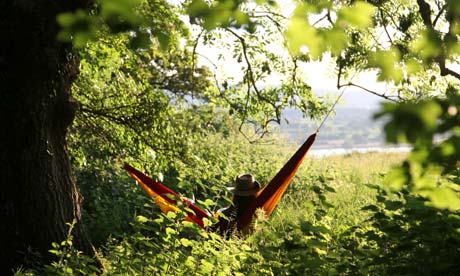
The Mendips, Somerset
Just 30 minutes from the centre of Bristol are the Mendip Hills, home to Goatchurch Cavern, a vast cave near Burrington Combe. It was once a Victorian show cave but has long since returned to the wild. Bring a torch and bicycle helmet, and leave yourself a trail of breadcrumbs so you can find your way out.
For an afternoon expedition take the spectacular six-mile circular walk around Cheddar Gorge, the deepest canyon in Britain, starting from Black Rock car park, near the top of the gorge. There are sheer cliff edges, rock pinnacles and you can spot peregrine falcons overhead. Returning to Black Rock, walk a mile east to Velvet Bottom, and explore the little known Roman remains including a rare example of a British amphitheatre. In summer, if you stay until dusk, you can see glow worms.
For sunsets in the Mendips you are spoilt for choice. The dramatic escarpment provides one of the best vantage points in the south-west. Deer Leap and Westbury Beacon, both south-east of Cheddar, are exceptional, and great places to fly kites. But my favourite sundowner hang-out is the remote hill fort at Sutton Wick, about 10 miles to the north-east. String up your hammock among the ancient oaks and watch as the sun sinks behind Chew Valley Lake. The next morning descend to the shore for a discreet dip.
For more lost ruins, head south-east towards Frome and find the little-known remains of the old Fussell iron works near Mells. They are hidden in a secluded stream valley and overgrown with wild garlic and moss. In spring, there are also superb wild daffodils nearby at Edford Woods, backtracking about 5 miles to the west, and a pretty stream for paddling and dam making, a lovely way to while away the day.
• Feast on award-winning, ethical food at the Ethicurean in Bristol, or take tea in the Mells Walled Garden
Isle of Purbeck, Dorset
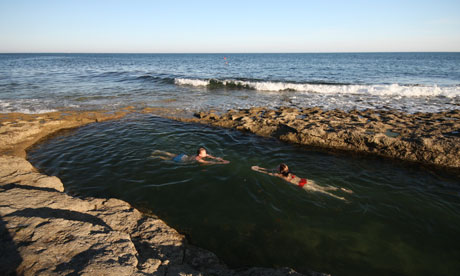 Taking a dip at Dancing Ledge, Dorset. Photograph: Daniel Start
Taking a dip at Dancing Ledge, Dorset. Photograph: Daniel Start
Escape the overcrowded beach fronts of Bournemouth and Weymouth and head for the dramatic chalk cliff-tops of White Nothe, located between the two. From the cliff tops, a tiny smuggler’s path leads down through ledges to a truly wild and hidden beach, perfect for skinny dipping and fossil hunting. About 15 miles further east along the coast there’s a good place to snorkel and swim in the crystal-clear lagoons of Winspit and Seacombe, and then explore the cliff-side caverns above – left by miners who dug stone for St Paul’s Cathedral. A mile to the east is Dancing Ledge, where you can dip in the tidal pool and then swim into the adjacent sea cave and hear the waves thrash and echo all around.
As the afternoon draws on, seek out summer orchids on the downland of Corfe Common, with views of the ruined castle; or head back west to near Dorchester and climb the ramparts of Maiden Castle, Europe’s largest iron-age hill fort. In the evening, a trip back down to the coast beyond Weymouth brings you to Chesil beach and its phosphorescent lagoon. If you can swim or canoe across you’ll find the wildest beach in the south-west.
• Collect picnic fare from Clavell’s Cafe and Farm Shop in Kimmeridge. Enjoy local food and ale with a side order of museum curiosities at theSquare and Compass in Worth Matravers (01929 439229,squareandcompasspub.co.uk)
Dartmoor, South Devon
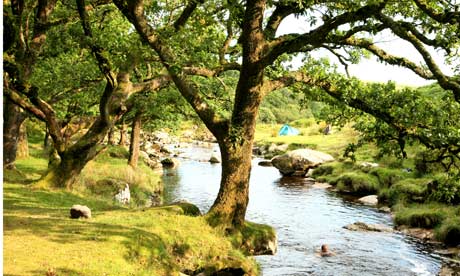 Swimming in the ancient grove of Piles Copse, Dartmoor. Photograph: Daniel Start
Swimming in the ancient grove of Piles Copse, Dartmoor. Photograph: Daniel Start
Swap the traffic-choked lanes and busy beaches of Dartmouth for the ancient stones and moorland streams of Dartmoor. Begin at the sandy river estuary of Mothecombe, the mouth of the tiny river Erme. You can canoe, paddle or swim upstream through the peaceful creeks and silent backwaters, inaccessible except by water.
There will be kingfishers, curlew and oystercatchers and, if you bring a line, you might catch sea bass. The Erme is a wonderful river in its upper reaches too, with waterfall pools at Ivybridge and the gnarled, twisted woods of Piles Copse, the most ancient fragment of Dartmoor’s once verdant forests – like something from the Hobbit. Continue up the Erme and, as views open out to the sea behind you, the giant standing stones of Staldon Row appear and beckon you on to Upper Erme Row. Stretching more than two miles, this is the longest stone row in Britain – possibly the world – yet little is known of its origins or purpose.
For a yet wilder experience, head east across the moor and explore the vast chamber of Pridhamsleigh Cavern, near Ashburton, or embark on a night walk. My favourite is the Lych Way which is a corpse road from Postbridge to Lydford – along which the dead were taken for burial. Set out on the walk by the milky light of a full moon. You will see the cart tracks of the coffin bearers, which are still visible, worn into the stone road.
Reach Coffin Wood near Willsworthy in the early hours, and fall into a deep, haunted sleep under the gentle sway of the ancient beech trees. The next morning you’ll deserve a hearty breakfast and a dip in the pools of Tavy Cleave, near Horndon, to wash away the spirits of the moor.
• The Castle Inn at Lydford does a good breakfast. Riverford shop and kitchen in Buckfastleigh is good for picnic and night-walk supplies
Near Newquay, North Cornwall
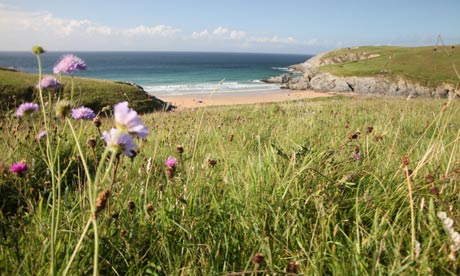 The view over West Pentire Head, near Newquay. Photograph: Daniel Start
The view over West Pentire Head, near Newquay. Photograph: Daniel Start
When you’re done with the bars and lights of England‘s surf capital of Newquay, head down the coast 20 minutes to kayak or swim out among the great stacks of Trevellas Cove. The brave jump from the pinnacle heights, but I prefer to watch while I forage for fat low-tide mussels on the waterline, then cook these up on a small fire (must be below the high-tide mark on the beach).
After this yummy snack, start to head back towards Newquay along the coast. First seek out the lost chapel of St Piran’s, buried under sand dunes near Perranporth, then continue on to explore the remote north end of the beautiful Holywell beach, where you will find a huge sea cavern that contains a holy well, flowing down through a series of calcite flowstones and natural pools.
As evening approaches, continue on for three miles to the poppy and corn-marigold meadows on the downs of West Pentire Head, near Newquay. As the sun goes down, keep watch for dolphins and basking sharks. You could shelter for the night in the sandy caves of Porth Joke beach below, or there’s a small campsite in a valley set well behind the beach.
Next morning, rise early and venture inland to the Cornish Alps near St Austell to seek out the white peaks and extraordinary opal-blue lagoons left over from the China clay industry, perfect for a morning wake-up plunge. There are eerie mining ruins to explore all around this area, including the remains of a giant waterwheel, leet and viaduct in magical woodland at Luxulyan, about 3 miles north-east of St Austell, or the lost valley of Tregarsus to the west. Or you could climb the iron ladder to the top of the extraordinary ruined hermitage at Roche to the north.
• For sustenance, try the funky Driftwood Spars in Trevaunance Cove (01872 552428, driftwoodspars.com) or the 17th century ivy-cladBolingey Arms, Perranporth (01872 571626, pubtrail.co.uk/cornwall/bolingey-inn-perranporth.htm)
Land’s End, West Cornwall
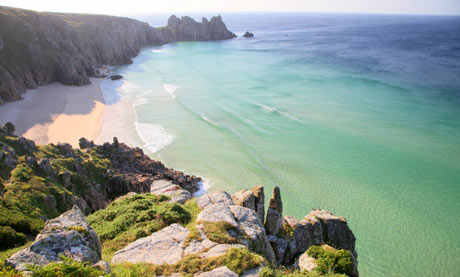
Pedn Vounder beach, close to Land’s End in west Cornwall Photograph: Daniel Start
Just a 20-minute walk along the coast from the bustle and arcade games of the Land’s End amusement park is the real edge of the Earth, at Nanjizal Bay. Here, at low tide, you can swim through the “song of the sea” rock arch, wallow in jade-green plunge pools and snorkel into sea caves gleaming with coralline. There’s also a rope by which you can descend to giant caverns and a secret beach.
For the wildest sands, head on a few miles to the atoll-island sand bars at Pedn Vounder, just east of Porthcurno, a spectacular bay with shallow lagoons. It’s a remote and wonderful place to while away the heat of the day paddling in turquoise waters.
As the afternoon draws on, take in some of the mystical bronze-age sites that adorn the landscape. Dance barefoot around the little-known Boscawen-Un stone circle, four miles north-east beyond St Buryan, explore the underground “fogou” burial chambers at Carn Euny, a mile further on near Sancreed, or head eight miles to the north coast and climb high onto the golden moor to the stone shelter at Zennor Quoit. Here, on a wild craggy outcrop, nearly 350m above the sea, there are stupendous views out over the western ocean.
Sleep beside the Quoit itself, or snuggle down in among the heather as night jars sing and stars fill the indigo sky.
• Above Pedn Vounder beach at Treen there’s a clifftop campsite and atiny cafe serving breakfast porridge with clotted cream, bilberry jam and heather honey
•Wild Guide: Devon, Cornwall and South West, charts more than 500 wild places to visit. It is published by wildguide.net on 1 May, £14.99
This entry was posted on Thursday, May 16th, 2013 at 7:15 am
You can follow any responses to this entry through the RSS 2.0 feed.
Posted in: Uncategorized

